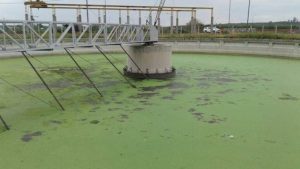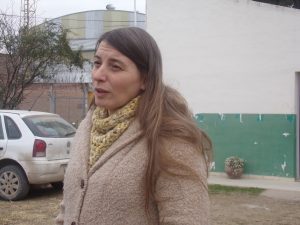Bajo Grande again in environmental and health emergency
The Municipality of Córdoba once again extended the environmental and sanitary emergency in the Wastewater Treatment Plant (E.D.A.R.) of Bajo Grande and in the downstream areas. It did so through Decree No. 3413 and the measure governs for 180 days. Neighboring Chacras de la Merced claim that the actions committed are not being met.
“Below, we offer a google translate version of the original article in Spanish. This translation may not be accurate but serves as a general presentation of the article. For more accurate information, please switch to the Spanish version of the website. In addition, feel free to directly contact in English the person mentioned at the bottom of this article with regards to this topic”.
On November 1, Mayor Ramón J. Mestre signed Decree 3413, which reinstates this part of the city of Córdoba in a state of environmental and sanitary emergency, by virtue of the status of the Bajo Grande plant.
The measure is in force for a period of 180 days, from the expiration of the terms of Decree N ° 15 dated January 12, 2018 (which extended the environmental and health emergency prepared in April 2017). Therefore, the deadline for the different departments of the Municipality to carry out all the actions contemplated in the Mitigation Plan would have ended last November.
This new emergency declaration recognizes the complex situation due to the contamination of the Suquía River, which continues to receive sewage effluents with minimal treatment or directly without treatment. For this reason, and the same determination had begun to take the municipality at least since 2014.
The decision was made after a court ruling that ordered the municipality and the province to implement a series of measures to mitigate the effects of pollution produced by the plant on the population, particularly in the Suquía and surrounding areas. Then, the measure was extended by Decrees No. 1220/15, 3745/15, 1292/2017, 015/18, and now by Decree No. 3413 in order to continue the mitigation plan for environmental and health effects. proposed for the Bajo Grande plant, located in the Chacras de la Merced neighborhood.
On the other hand, work continues on the expansion of the plant that according to the information provided by the Province once completed will benefit some 960 thousand Cordoban. These works would conclude in the second half of the year 2019.
Information requests: no satisfactory answers
In the month of March, and within the framework of the emergency decreed by the municipal government, together with Las Omas, civil association of neighbors of the Chacras de las Merced district, we made several presentations before the Secretariat of Government, Citizen Participation and Social Development, the General Secretariat, the Public Services Secretariat, the Ministry of Health and the Secretariat of Planning and Infrastructure of the Municipality of Córdoba. The orders requested information about the progress of the mitigation plan in Bajo Grande and downstream areas. Given the lack of response from the municipal administration, we present a prompt dispatch in the month of June.
The Ministry of Health was the only division that answered, but it did so incompletely and with information that contradicts what was reported by the people from the plant. While the municipality maintains that in the health centers of the area there is no shortage of stock and supplies and that human resources are sufficient to respond to the problems and affections of the neighborhood, the neighbors complain that “there are never enough medicines, ambulances do not want to enter the neighborhood because of the state of the roads and that there is only one doctor in the area who can not cope. In addition, the neighborhood health center only attends in the morning and when the doctor does not go, there is no replacement. ”
As reported by the Municipality of Córdoba, cases of Acute Diarrheal Disease (EDA) decreased between 2012 and 2017. However, in the Health Center No. 84 of the Chacras de la Merced District, in 2017 the cases of diarrhea increased with respect to 2015 and 2016, which shows that diseases that could be the product of water pollution persist and continue to affect the community.
Regarding this, Alida Weht, president of Las Omas, states that “the conditions did not diminish, what happens is that due to the large number of cases there are, people begin to naturalize them and stop consulting the health centers of the sector, for the lack of response and medicines for the treatment of these diseases. ”
The sanitary actions contemplated in the Mitigation Plan are: continue with the weekly evaluations of tracer pathologies (diarrhea, hepatitis, conjunctivitis, meningoencephalitis, HUS and others); ensure the provision of medicines and nursing supplies in a timely and sufficient manner; guarantee the availability of human resources for the care of patients in the affected area, with accompaniment and participation of the community; continue with networking with other nearby Health Centers and Institutions, among others.
However, Alida Weht, stated that there are currently numerous cases of gastroenteritis, dermatitis, conjunctivitis, skin and eye irritation, respiratory diseases and that the actions committed in the mitigation plan would not be fulfilled. “They are diseases typical of the area, having pneumonia every year is a normality,” he adds.
The situation of vulnerability that lives in the community located next to the purification station is, today, unsustainable and degrading. Similarly, the malfunction of the plant has persisted for years, even the employees of the plant have acknowledged that they have reached almost 100% of the untreated liquids in the Suquía River.
From FUNDEPS we are concerned about the continuity of a situation of environmental degradation and violation of human rights. As Juan Carballo, Executive Director of FUNDEPS, expresses, “the situation is very worrying: a context of serious and continuous environmental impacts would require minimum of the authorities to report on the situation permanently. That does not happen at present; an expansion of the plant without adequate citizen participation, a deficient operation but without certain data and unanswered information requests further aggravate the situation “.
The situation is even more worrisome, if we take into account that there are eight municipal officials charged by the federal justice for the situation of the Suquía River, there could be evidence that the contamination has reached the mouth of the Rio Primero in the Laguna de Mar Chiquita.
This demonstrates the failure of the mitigation plans assumed each time the environmental emergency has been decreed since 2014. It has also been clear that the actions implemented have not been sufficient to mitigate the effects of the contamination of the Suquía River; and the situation of lack of protection suffered by the people of the Chacras de la Merced neighborhood.
We renew once again the claim for a definitive solution to the pollution of the Suquía River and, especially, for the guarantee of the rights of those who have been and continue to be affected.
More information:
Contact:
María Pérez Alsina – mariaperezalsina@fundeps.org
Agustina Palencia – agustinapalencia@fundeps.org









